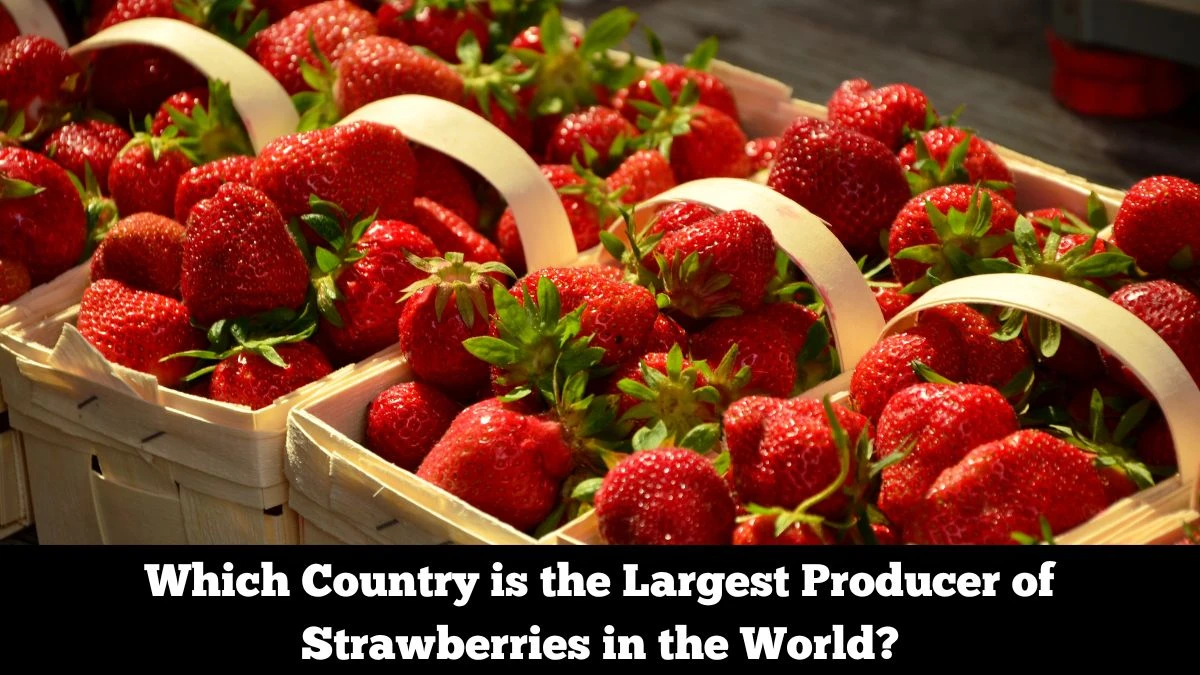Which Country is the Largest Producer of Strawberries in the World?
China dominates global strawberry production and has held the top position since 1994. The country produces approximately 3.4 million tons of strawberries annually, representing the largest share of worldwide production.
China's strawberry industry is considered a crucial economic fruit crop, with cultivation occurring across virtually every region of the country.
The key producing provinces in China include Hebei, Shandong, and Liaoning, which together account for more than 60% of the country's total strawberry output.
China's dominance in strawberry production stems from its vast agricultural land, favorable growing conditions in multiple regions, and significant investment in agricultural infrastructure.
Top 5 Strawberry-Producing Countries in the World
Based on the latest production data, here are the world's five largest strawberry producers:
| Rank | Country | Annual Production |
|---|---|---|
| 1 | China | 3.4 million tons |
| 2 | United States | 1.3 million tons |
| 3 | Turkey | 728,000 tons |
| 4 | Egypt | 638,000 tons |
| 5 | Mexico | 568,000 tons |
1. China - 3.4 Million Tons
China's massive production capacity makes it the undisputed leader in global strawberry production. The country's structured agricultural policies and extensive farming regions contribute to this remarkable output, making strawberries the world's 19th most popular fruit.
2. United States - 1.3 Million Tons
The United States ranks second globally, with California responsible for approximately 90% of American strawberry production. The remaining 10% comes from Florida, Oregon, North Carolina, and Michigan. The US strawberry industry has a market value exceeding $3 billion, with California's favorable climate allowing for year-round harvesting.
3. Turkey - 728,000 Tons
Turkey has emerged as a strong competitor in the global market, producing approximately 728,000 tons annually. The country has invested heavily in modern agricultural practices, with the Bursa and Sakarya regions being particularly renowned for strawberry cultivation. Turkish strawberries are recognized for their high quality and have found strong export markets, especially in Europe.
4. Egypt - 638,000 Tons
Egypt has rapidly increased its strawberry production in recent years, benefiting from favorable climate conditions that allow for extended growing seasons. The primary strawberry-producing regions include Ismailia, Beheira, and Qaluobia. Egyptian strawberries have an estimated market value of around $400 million and are increasingly exported to international markets.
5. Mexico - 568,000 Tons
Mexico rounds out the top five with significant production centered in Baja California, which benefits from mild climate conditions and rich soil. The Mexican strawberry industry is valued at approximately $800 million, with substantial exports to the United States and other international markets.
Which Other Countries are Strawberry Producers?
Beyond the top five, numerous countries contribute significantly to global strawberry production:
Major Secondary Producers
Spain produces approximately 326,000 tons annually, with the Huelva province serving as the heart of Spanish strawberry production. Spanish strawberries are often marketed as premium products in European markets and command high prices during off-season periods.
Russia has steadily increased production to around 255,000 tons annually. The Krasnodar territory in southern Russia is the primary cultivation region, with the government encouraging domestic production to reduce import dependence.
Poland stands as the largest strawberry producer in Central and Eastern Europe, generating approximately 199,000 tons annually. The country is particularly renowned for producing high-quality frozen strawberries for export, primarily to European Union markets.
South Korea produces around 193,000 tons of strawberries, with Nonsan being a key cultivation region. The country is famous for cultivating specialty varieties like Seolhyang strawberries, which are prized for their exceptional sweetness.
Brazil contributes approximately 184,000 tons to global production, representing significant growth in the South American market.
Notable Specialty Producers
Japan produces around 130,000 tons annually but commands remarkable market value due to premium pricing. Japanese strawberries often sell as luxury items and are known for exceptional varieties including Amaou, Sagahonoka, Tochiotome, Benihhope, and Hatsukoi.
The country employs innovative cultivation techniques including hydroponics to maximize yield and quality.
Morocco has recently emerged as a significant player, producing approximately 167,000 tons and ranking among the top 10 global producers. This achievement underscores Morocco's growing importance in the international agricultural market.
Canada produces around 95,000 tons with a focus on organic farming practices and high-quality varieties, catering to growing consumer demand for organic produce.
Regional and Emerging Producers
Other countries contributing to global strawberry production include:
- Italy - Known for quality exports and innovative growing techniques
- Peru - Emerging as a significant exporter, particularly of frozen strawberries
- Chile - Important Southern Hemisphere producer
- Netherlands - Advanced greenhouse production systems
- France - Traditional European producer with focus on quality
- Germany - Significant domestic production and consumption
- Belgium - Notable for greenhouse cultivation
- Greece - Mediterranean climate advantages
- Iran - Growing Middle Eastern producer
- Argentina - Expanding South American production
Market Dynamics and Global Trends
The global strawberry market generated approximately $4.81 billion in export sales during 2023, representing a 24.9% increase compared to 2019. Fresh strawberries account for 73.1% of worldwide exports, while frozen strawberries represent 26.9% of the global market.
Growing Demand: Agricultural experts report that farmers worldwide are planting more strawberry acres to meet increasing global demand. The fruit's versatility in culinary applications and high nutritional content drive this growth.
Climate Challenges: Increasingly unpredictable weather patterns and climate events have impacted strawberry crops globally, sometimes causing demand to exceed supply in certain regions.
Quality and Logistics: Since strawberries are delicate crops requiring precise harvest timing and immediate refrigeration, most strawberries don't travel far from their production regions unless adequate refrigeration and shipping infrastructure exists.
Nutritional Appeal: Strawberries continue growing in popularity due to their exceptional nutritional profile - eight strawberries contain more vitamin C than one orange, plus significant amounts of potassium, manganese, iron, calcium, magnesium, and folate.
Disclaimer:
The information provided in this article is based on the most recent data available as of 2025. Annual production figures and market values may vary depending on regional agricultural trends, climate conditions, and market dynamics. The data presented is intended to offer a general overview of global strawberry production and may not reflect the most up-to-date figures or changes in the industry.







